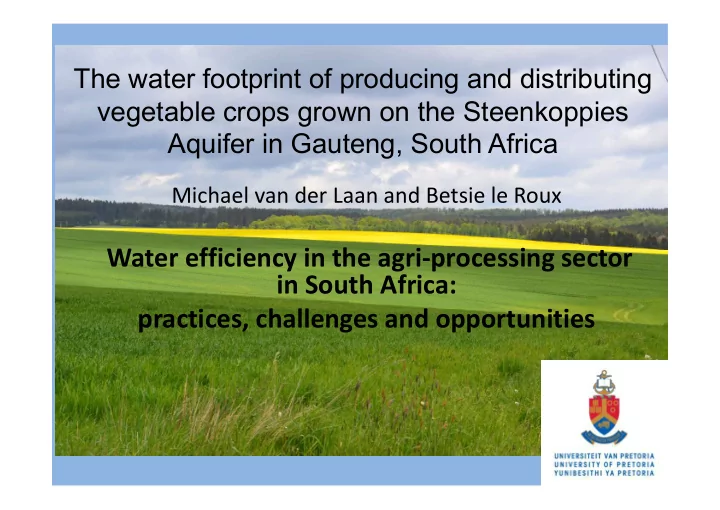

The water footprint of producing and distributing vegetable crops grown on the Steenkoppies Aquifer in Gauteng, South Africa Michael van der Laan and Betsie le Roux Water efficiency in the agri-processing sector in South Africa: practices, challenges and opportunities
Virtual water • Virtual water accounts for all the water used to produce a product • Useful to monitor the virtual flow of water between regions • When reported as a water footprint it includes information on what, when and where Photos: Google images
Virtual water flows
Definitions of water footprint terms Blue water refers to surface water (rivers, lakes, dams) and groundwater available to multiple users Green water is water originating from rainfall that is stored in the soil Grey water (footprint) refers to the volume of water required to dilute emitted pollutants to ambient levels
Calculations 𝑛𝑗𝑜
Fresh mass
Crop water footprints Average seasonal WFs of crops (m 3 tonnes -1 ) Crop Month Blue Green Blue + Green Grey Carrots Summer 36 25 61 48 Autumn 104 12 116 60 Winter 88 7 95 52 Spring 45 17 62 39 Cabbage Summer 38 29 66 66 Autumn 53 11 64 31 Winter 77 1 79 18 Spring 63 16 79 46 Beetroot Summer 60 40 100 92 Autumn 87 14 101 33 Winter 121 3 124 20 Spring 104 15 118 96 Broccoli Summer 142 120 262 183 Autumn 225 76 301 575 Winter 322 5 327 540 Spring 170 44 214 214 Lettuce Summer 31 24 56 100 Autumn 51 20 71 131 Winter 93 1 93 56 Spring 56 6 62 80 Maize Summer 452 253 707 377 Wheat Winter 732 30 762 443
Blue plus green water footprint to supply a man (aged 31–50) with their Recommended Dietary Allowance (RDA) in terms of selected nutrients
Packhouse water footprints Packhouse blue water footprint of 1,8 1,6 1,4 1,3 crops (m 3 tonnes -1 ) 1,2 1,0 0,9 0,8 0,6 0,3 0,4 0,2 0,0 Carrots Cabbage Lettuce Crops
Relative water footprints Lettuce 0.003% Carrots 0,05% 55% 35,89% 0.5% 0,93% 2% 3,85% 1.5% 2,87% 60,26% 43% Packhouse grey WF Packhouse blue WF Cultivation blue plus green WF Cultivation grey WF Packhouse grey WF Packhouse blue WF Cultivation blue plus green WF Cultivation grey WF
The in-field water footprint (evapotranspiration) is often >98% of the total water footprint
Wastage
Wastage along supply chain 8% 12% Farm Market 9% Retail Consumer 70%
Average annual wastage
Wastage – correct term?
Irrigation water use on Steenkoppies
Catchment level irrigation WF 35 31 Agricultural water use on the Steenkoppies Aquifer (Mm 3 ) 30 6 25 Assumed 25 blue + green 5 Green 20 Blue 13 15 25 10 20 4 13 5 2 4 2 0
Wastage
• If we use the maximum maize blue water footprint obtained in this study (676 m 3 tonne -1 ), this equates to 8.4% of river flow (10 002 l s -1 ), while if we use the minimum blue water footprint (338 m 3 tonne -1 ), this equates to 4.4% of river flow (5 001 l s -1 )
Yield = genotype (G) management (M) environment (E) Yields <50% of realistically attainable yields in many parts of the world (e.g. SSA)
Conclusions - general • Awareness raising among consumers through water footprinting has been great • But product labelling of specific water footprints will not happen (MvdL) • There are the socio-economic factors linked to water use that are not captured by a water footprint
Conclusions – eco-labelling • Values can differ widely for same crop in different seasons and different areas • “Interesting information, but not for decision making” (consumer or government) • Water systems complex, no method can produce a single metric as with carbon footprint
Conclusions – methods • Application depends on objectives, we now have more tools in the toolbox, plus they can be used synergistically • Farmer benchmarking – will need to be for a specific area
Acknowledgements • Water Research Commission Project K5/2273 ‘Estimating the water footprint of selected vegetable and fruit crops in South Africa’ • National Research Foundation • Prof Keith Bristow, Teunis Vahrmeijer, Prof John Annandale
Recommend
More recommend